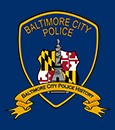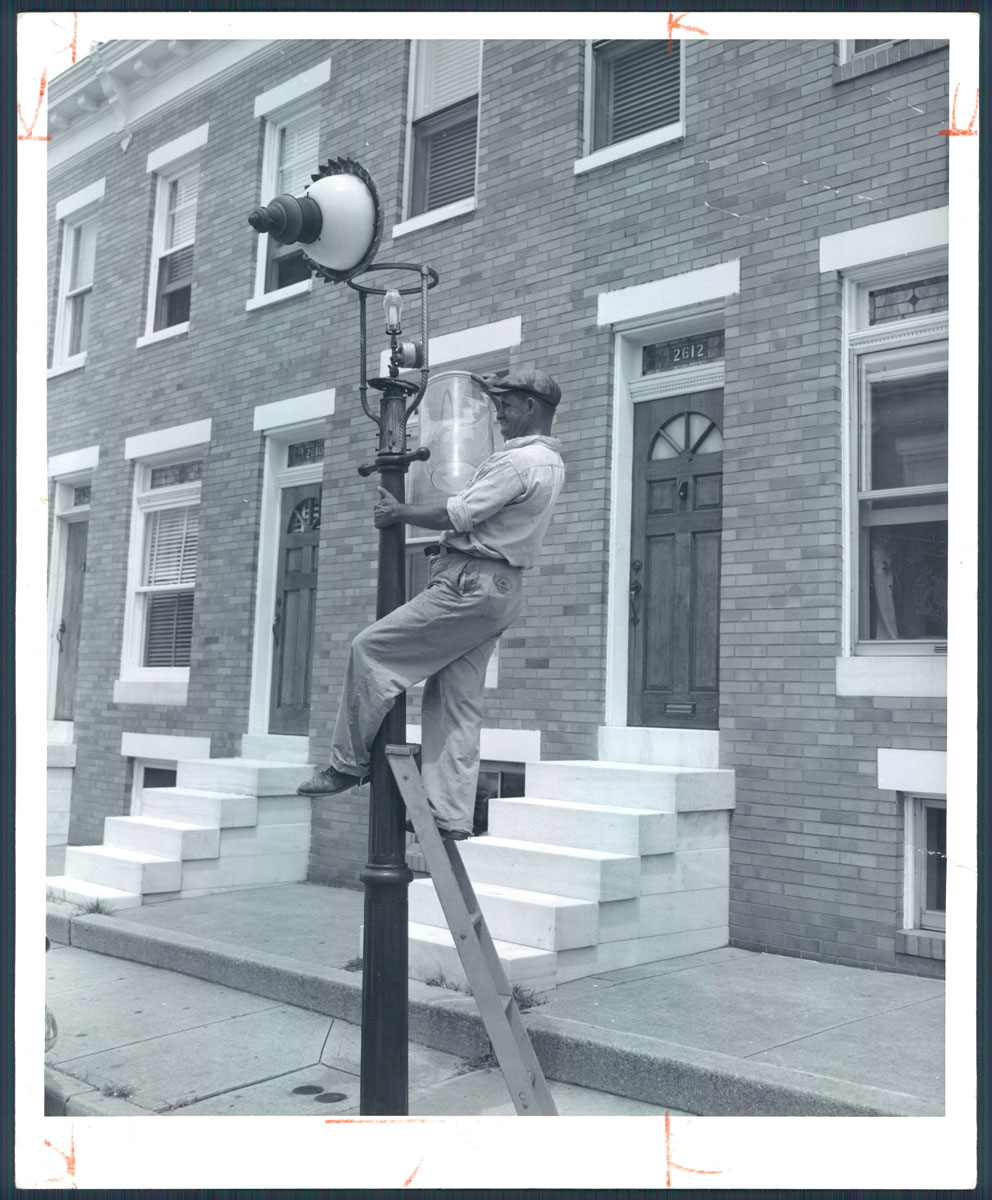Recall Lights
Every story has a beginning, so let's go back to January 1918, when John Martin Superintendent of Baltimore's Telephone and Signal Division first obtained his position as a Lineman with the Baltimore Police Department. At that time there was a Lieutenant and a Sergeant acting as the Superintendent and Assistant Superintendent of the Telephone and Signal Division, five linemen. They used one truck and two touring cars for construction and maintenance of the entire system.
Recall Light System
This is the Fourth Model/Issue Baltimore Recall Light
Notice the Top is Brass with a Removable top to Swap out Bulbs

"Recall System"
POLICE SOON READY WITH NEW ALARMS
Will Be Completed
5 Sept 1922
In Two Districts Early Next Week. Plans City-Wide Extension - Gaither hopes to have All Baltimore Covered by Light Signals next Year. - After delays and complications for more than six months the new police "recall system" will be completed early next week [17 Sept 1922] in the Central and Western districts, it was announced yesterday by Charles D. Gaither, Commissioner of Police. This system, conceived by the Commissioner, will be official, it has been approved after its trial and will be established throughout the city by next year, Mr. Gaither said, providing an appropriation permits it.
Having been tested through experiments with the call-box at Baltimore and Charles streets and in outlying sections of the Northern District, the system is regarded as feasible and satisfactory and is expected to aid in the quick capture of criminals. Through the "Recall" patrolmen all over the city can be summoned immediately and instructions were given to the entire force at one time.
How System Works
All police call boxes in the Central and Western Districts are being equipped with a "red light" projecting over the top of the box. A cable connects with the series of boxes to the respective districts and with headquarters. When a patrolman is wanted his box is "flashed." And the light blinks until the telephone receiver is removed from the hook. If the entire force is wanted every box flashes simultaneously until answered. Under the present system, there are no means of obtaining communication with patrolmen on the street. The policemen call their respective districts every hour and between the hours of call unless someone is dispatched to call the officer wanted. There are no means of locating him. When the light flashes the officer will know that his district wants him and he will answer.
City-Wide System is Good
“The plan is a good one. I think.” commented Mr. Gaither ... “and by next year we hope to have the system installed in all of the eight districts. If all of our appropriations is sufficient this will be done. We were delayed this year when we received the wrong equipment and had trouble in obtaining the correct cable. The siren system, as established in New York banks, was commended by the Commissioner. Banks in downtown New York have been equipped with huge horns that are blown in cases of robbery or hold-ups, and attention is immediately attracted to that point. The idea could be adopted here advantageously.”
Gaither suggested this program and it was not only successful here in Baltimore, but it was a system that would be adopted by departments up and down the East Coast.
Notes - In the article it says these lights would be "RED," they may have started out red and in fact, when the program ended in or about 1985/86 we had one or two red lenses, along with one blue lens, the rest of these recall lenses were a dark almost brown amber color. The lenses or globes were made to be used in the maritime industry on things like buoy, ship lanterns, and for other types of nautical globe uses. A Fresnel lens was the type lenses used. Fresnel lenses were compact lenses originally developed by a French physicist named Augustin-Jean Fresnel; they were originally designed for use on lighthouses. A Fresnel lens could capture more oblique light from a light source, allowing the light from a lighthouse or other light source using the Fresnel lens to be visible over greater distances. While not 100% the same as the Fresnel lens, another place we found a use for adding a design to glass to give a better reflective nature was on the traffic light. These older Fresnel lenses/globes can be hard to find and expensive. A replacement globe was recently purchased from a Maritime Salvage Company for more than $100 it was red in color and we were told if we wanted Amber or Blue it could cost as much as 4 to 5 times what we paid for the red globe.
Interesting Side-note - When the Recall System went into effect, patrolmen were said to have offered neighborhood kids a small reward to be the first to locate the officer and notify him of the light's activation. With this officers were building a rapport with the community while patrolling his post.
![]()
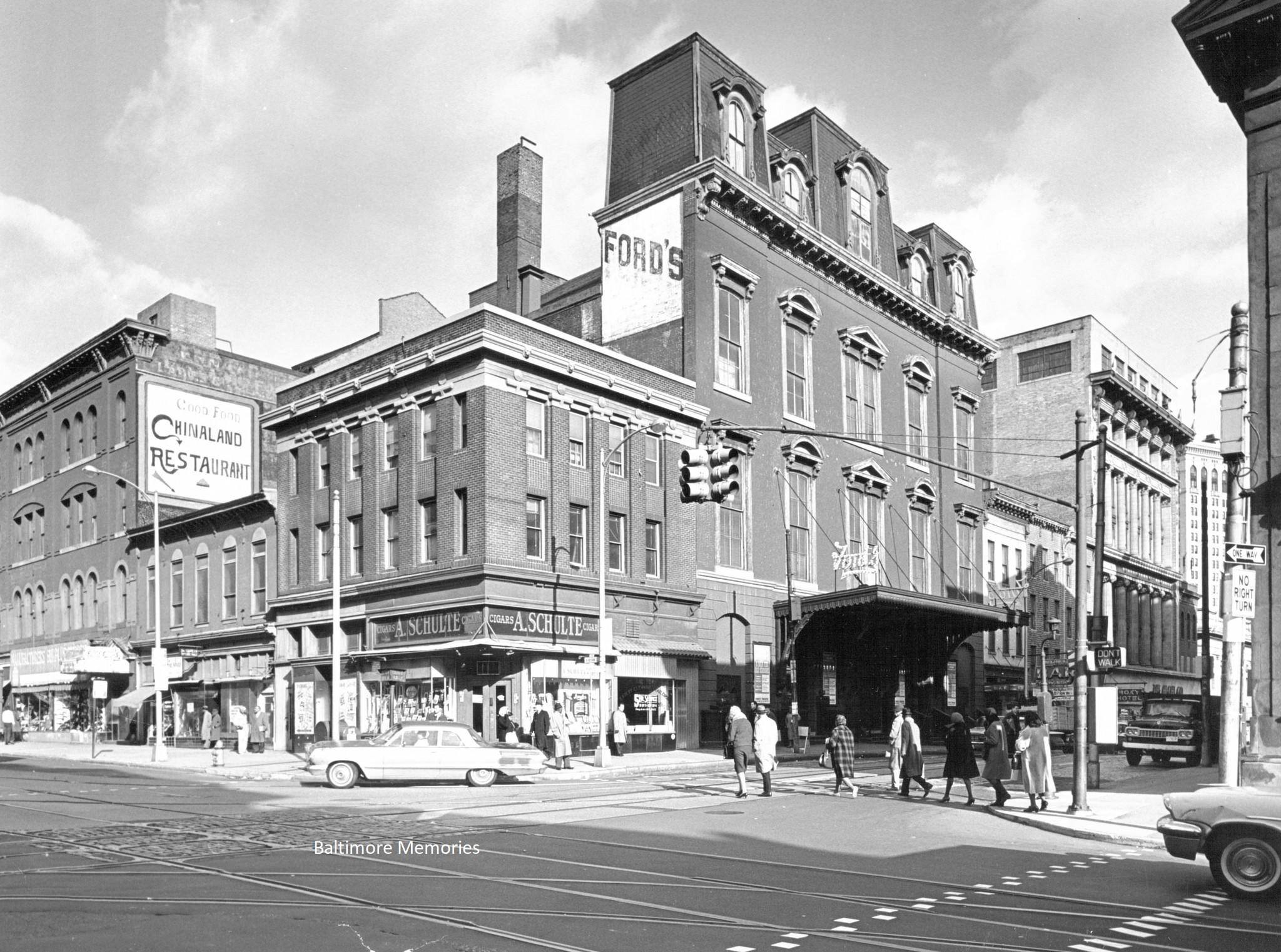
Police Find Magic in Blinker System
24 September 1922
Text of New Device Create Demand for General use Over City.
Protection is increased
Woman at Switch Can Summon All Patrolmen of District with 35 Recall Lights
A week ago, today police of the Central District began operating the new Police Recall System. Yesterday every uniformed man from the inspector to patrolman was enthusiastic over the results. The first week of the “Blinkers” has created a demand from other districts that the system be installed immediately.
Action in reaching the men on the street has been facilitated, a greater speed of broadcasting information has been attained and a more perfect cooperation between them and patrolling his post and his headquarters has been created.
The Central Police District is a large one. The line runs from Liberty Street to Park Avenue, to Preston Street, to Maryland Avenue, to North Avenue, to Greenmount Avenue, to Forrest street, to Orleans Street, to Aisquith Street, to Baltimore Street, to West Falls Avenue to Pratt Street. In this area there are Thirty-nine Patrol Boxes. Thirty-five Recall Lights had been installed.
Woman operates system
The light is a Small Green One surmounting the Patrol Box. From her desk at the Central Police Station Miss Mary A. Little, Telephone Operator, can get into communication with the police within 2 minutes. The lights are also within view of two patrolman in the Southern District and two men in the Northern District. Men whose posted touch the border line of the central district.
The police have been instructed that one of the first duties is to watch the Green Globe. In the District Headquarters on Saratoga street, near Charles, there are four circuits, one for each quarter of the district. On information received from Police Headquarters or other District Headquarters Miss little throws on a switch. This immediately lights the Green Lights on the Patrol, or Call Boxes, which begin “Blinking.” The Patrolman is expected to answer at once.
Patrolman found quickly
The switchboard is so constructed that Ms. Little can call on either the entire district, or any quarter section required. Demonstrating the efficiency of the system yesterday she threw the switch calling the entire district. In 20 seconds, 13 patrolmen answered. Others quickly followed until every man in the district had answered. The last man answered within four minutes.
On 6 June 1922, "Blinkers" were installed in the Northern Police District. Their located at Cold Spring Lane and York Road, Charles Street and University Parkway, Upland Road and Roland Avenue, Falls Road and Cold Spring Lane, Charles Street Avenue and Belvedere Avenue and Belvedere in Park Heights Avenues. Mrs. Bessie Cronin is the operator in charge of the Blinkers.
With this system installed in the Seven or Eight Station Houses of the time, a Central Bureau was expected to had been established at Police Headquarters from which information could be broadcast to the District Headquarters simultaneously.
This is important because around the time the Recall System was being developed; Gaither was struggling to have a “Uniform Traffic Light System,” recognized nationwide. He wanted one standard system with three colors, Red, Amber, and Green. We know he didn’t want, Red or Green used in his Recall System. In fact, the only reason Amber would have even been considered was the Amber used on the Recall System, and the Amber used in the Traffic Light system were two very different colors. The Amber on the Recall System has often been described as Brown, while the Amber of a Traffic Light is frequently defined as Yellow.
![]()
Police Lights Nemesis of Evildoers
8 Nov 1925
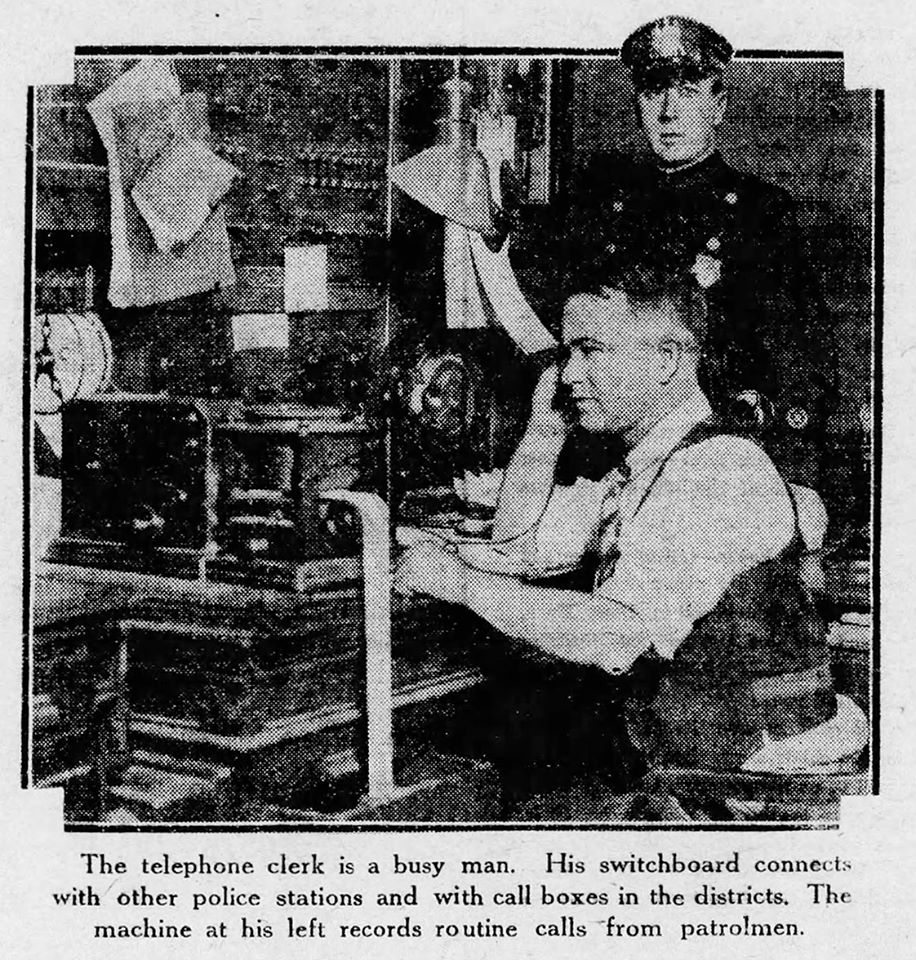 Click Pic Above to Read Complete Article
Click Pic Above to Read Complete Article
![]()
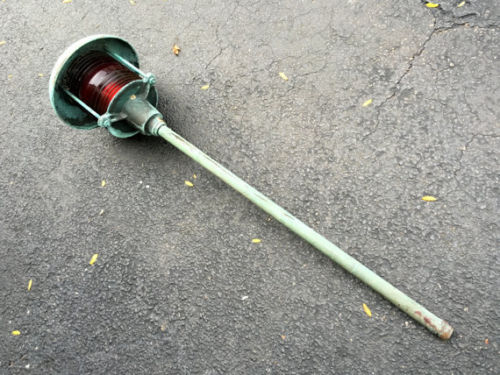
Courtesy of John Heiderman
This came from the old Headquarters Building and has a Red Globe/Filter on a brass frame, it is believed to have possibly been once used on a Call Box down by the Harbor.
![]()
 Click HERE or on the article above to open article
Click HERE or on the article above to open article
Police Green Lights Replaced by Amber
15 November 1927
Atop Call Boxes, Former Were Confused with Traffic Signals, is Claim
Police no longer answer the Blinking Green Lights on top of Call Boxes . The Green Lights are Amber Lights now.
Slightly more than four years ago the powers that be, conceived the idea that a signal on a Call Box could summon the officer in an emergency. On top of nearly every box the “Blinkers” were put. It was controlled by the signal clerk, who answers all calls that come into the station, and all the lights can be set going, or just a few in one circuit.
Burn Steadily, or Blink
The lights can be made to burn steadily, which calls the officer but spreads no alarm, or they can be set to flashing on and off, which is the celebrated “Police Alarm.” Officers are allowed very few minutes to answer a Blinking light without having to answer as to why they didn't answer sooner.
But then came to modern improvements in the form of traffic signals. Traffic signals flash on and off, and Green is the most noticeable color about them. Another concern of the times was that drug stores used to habitually exhibit large globes of a green liquid behind which a light used to burn. The two combined in having police answer alarms that were not Call Box alarms but traffic Lights, or Drug Store advertisements. Worse, Vehicles may have entered an intersection for a Green light that was actually the solid light of a Recall System, likewise they may have stopped for a Steady red lamp of the Recall System causing potential accidents. With that, Green and or Red lights on the Police Recall System were changed to Amber lights in 1927.
Note: in the late 70s and early 80s as some of these old Recall Lights were being collected from various street corners removed from Call Boxes, there were several Red, Green and Even Blue Globes collected. We have one Clear globe collected, perhaps someone saw it as a way of adding the color light bulb they wanted to get whatever color the city decided on at the time. Throughout this page we'll find several Newspaper articles, they can be clicked to see the full size article that will tell us of these color changes over the years.
![]()
Finds an Alleged Stolen Car Just as he Gets Report
27 November 1927
Police Sgt. Arrest Port Clinton (Pa.) Man, Who is Said to admit to theft. Sgt. Frederick Korn of Southwest District, was standing at the corner of Carrollton Avenue and Baltimore Street last night when he saw a green police light flash. Answering his box, he was given the number of an automobile bearing a Pennsylvania license plate reported to have been stolen. As he hung up the receiver and turned around to watch traffic the machine he had been told to look out for drove up in front of him and stopped at the red traffic light. At the Southwestern police station where Sgt. Korn took the car and its occupants, the driver identified himself as Harry Hines, 21, of Port Clinton, Pennsylvania, and, according to the police, confessed to having stolen the car in Port Clinton. The automobile it was said, belongs to Charles W. Grief of Port Clinton. Four other men were in the car at the time the arrest was made. Hines was held on a charge of theft.
![]()
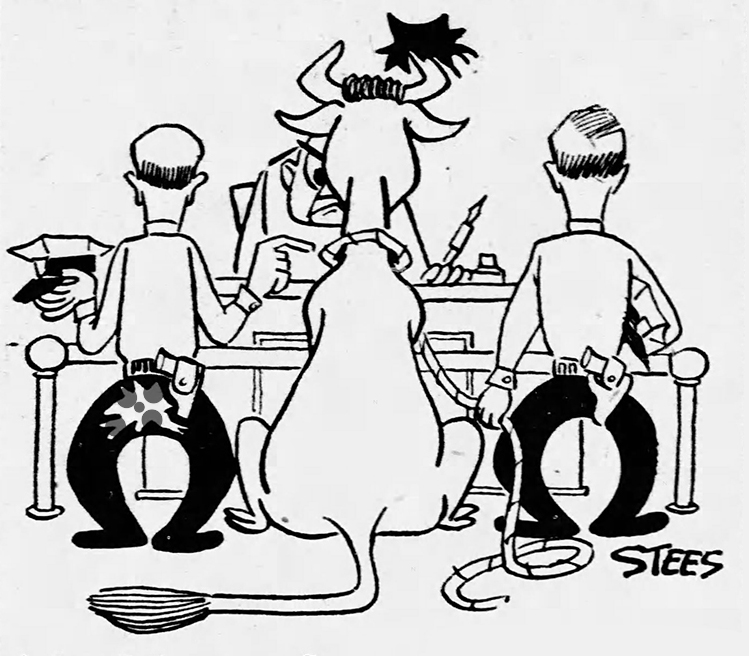
Runaway Cow Center of one Animal Rodeo
14 October 1928
Bovine hit by two autos and streetcar bumps tree and charges children Amber police lights in a southwestern district flashed at 1030 o’clock last night. As each patrolman answered, he was instructed to “watch for a wild cow.” Meanwhile, residents of the district were spectators of a one animal rodeo show, and the cow, which escaped from a herd at Brunswick Street and Wilkins Avenue, continued on its way. Witnesses reported it was bumped by two automobiles and a streetcar and ran head down into a tree. At Gilmore and lumbered streets, several men tried to hold its progress by swinging on its tail. Patrolman Edward Twelve finally subdued the breathless animal at Highlands and Calhoun streets, after it had attempted to charge a group of children. The cow was turned over to its owner, Edward W. Bartlett, at the bank and Third streets
![]()
Recall Lights Out
30 August 1936
All lights of the recall system – the blinker method of calling patrolman to their post boxes – were put out in the Central District. Police were unable to say whether lightning or floodwater caused the interruption. Lightning fired a barn on Dekol Farm, the estate of Luther J. Pierpont, on the Johnny Cake Rd., Kingsville. Despite efforts of the Catonsville regular volunteer fire companies, the barn and 40 tons of hay burned. Some farm machinery was destroyed, but all livestock was saved. At the height of the second storm in the city, a number six streetcar was derailed at Hanover Street and the types of go Avenue. Its crew said the breeze washed onto the tracks caused the mishap. None was injured, and the car was returned to operation speedily.
![]()

History of Baltimore's Recall Light System
This is the Second Model/Issue Baltimore Recall Light
Notice the Top is a High Bell Shape, it has Two Bolts that come off to Remove the Top
March 1945
A program that was initiated in 1921 gets off the ground on this day in 17 Sept 1922 - We had installed a signal light on top of a Call box, the location of which was on the Southeast Corner of Baltimore and Charles Street. The signal was made up of an electric light bulb, a washbasin to shade the bulb and a Marine lens. The mechanism for the operation of the light was located in the old Central Police Station House on Saratoga Street near Charles Street, it consisted of an alarm clock for the flashing apparatus. This method of notifying an officer that he was wanted, proved very successful and at this time (March 1945). There were 269 recall lights in operation throughout the city, on a much more improved pattern than the first one. The 1945 Recall system consisted of one commercial sign flasher in each district station houses, which carried 110V to each Recall Light's location on Call boxes, and were operated with a steady, or flashing light by the telephone operator in each district. The above method applied to all districts.
Note: These Recall Lights were initially handmade by our maintenance crew. Police of the Central district began operating the new police Recall system. Every uniformed man from the inspector to patrolman was enthusiastic over the results. The first week of the "Magic Blinkers" has created a demand from other districts, and other jurisdictions around the country... that the system would be installed everywhere immediately. Early in the year of 1921, a signal light was installed on the control box located on the southeast corner of Baltimore and Charles Street. The signal was made up of an electric light bulb, a wash basin to shade the bulb and a Marine lens.
The mechanism for the operation of this light was located in the old Central Police Station on Saratoga Street near Charles Street and consisted of an alarm clock for the flashing apparatus. This method of notifying the post officer was very successful; before long they would have 269 Recall lights in operation throughout the city, on a much more improved pattern than the first one. The present recall system consists of one commercial sign flasher in each district station house, which carries 110 V to each recall light located on Call boxes and is operated with a steady or flashing light by the telephone operator in each district. The above method applies to all districts.
![]()
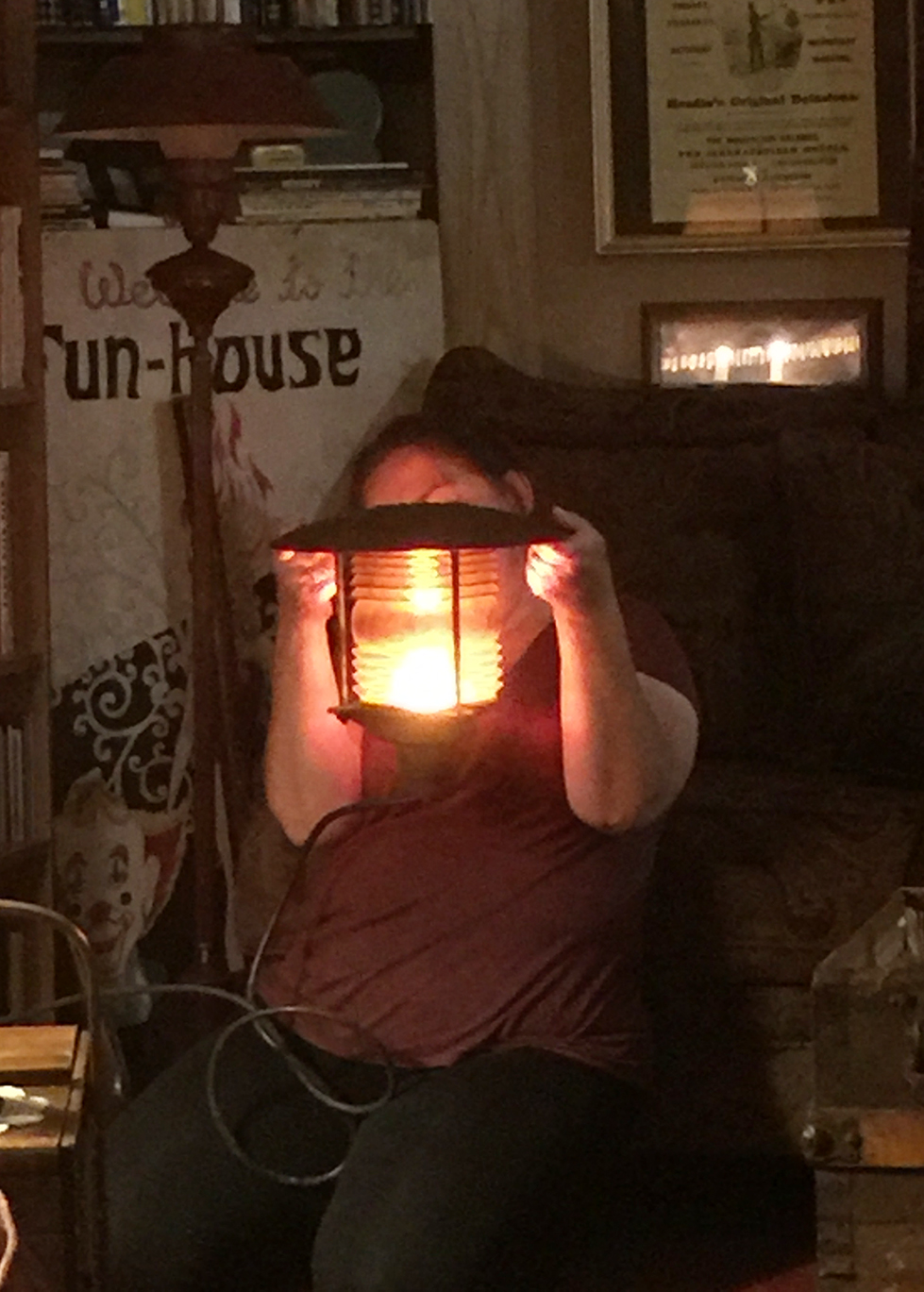
Early Recall Light
This is the color described as AMBER
This is the First Model/Issue Baltimore Recall Light
Notice the Top is Flat Pan Shaped
This was homemade here in Baltimore by our construction and repair machinist who used spare parts from around the department and Marine Unit. The way this worked was as follows - If it were me, and I saw the light on, I would have gone to the Call Box, and answered like this: “ This is Officer Driscoll, on the light.” If I were simply making your required hourly call, I would have said: “This is Officer Driscoll on 525, or whatever box I was using.” The operator then knew exactly where “we” were.
![]()
Installation of more Recall Lights
Click HERE to See Full Size Article
![]()
Police all Over State Quickly Informed of City Bank Robbery
1 August 1923
Within 5 to 50 minutes after the holdup had been reported to police headquarters by means of the “Call Box” system the green lights atop patrol boxes in the city and suburbs, nearly every policeman on duty has been supplied with the description of the street bandits. State police patrolling the roads leading from the city also were notified.
Police officials, in speaking of actions to be taken in cases of holdups, say that speed getting an accurate description of the bandits is the most important factor. In such cases the first policeman to arrive on the scene is instructed to call his police station, to inform his commanding officer of what has happened and to give an accurate description of the hold-up men.
In today’s case, patrolman Harry Bryan was the first to learn from the bank teller what had happened. He immediately notified Captain Mintiens, of the Central District. Meanwhile, Sergeants Becker and Rosensteel, at police headquarters flashed word to the Captain of Detectives Charles Burns, who, in command of a squad of detectives, rushed to the bank an automobile. Uniformed police under Captain Mintiens arrived a few minutes later.
![]()
Installing Police Lights
14 September 1923
Eastern District Being Equipped with Green Flash Signals
Electricians have begun the work of installing "green" flashing lights over patrol call boxes in the Eastern Police District. The task of laying the wires will require about one month, and when it is completed only two of the city’s 8 police districts – The Southern and The Southwest will be without the new green flashing light system that will be used for summoning patrolmen. The Southern District will be equipped next with these green flashing lights and when the work is finished the lights will be installed in the Southwestern District.
![]()
1921 - It was necessary for the police call box system to be extended due to the Annexation. This required the installation of 135,000 feet of overhead telephone wire additional police call boxes. It was also necessary to increase our personnel from 5 linemen to 9 linemen and one additional chauffeur.
1922 - 17 Sept 1922 - Recall Lights are put to use for the first time in the country. Police of the Central district began operating the new police recall system. Every uniformed man from the inspector to patrolman was enthusiastic over the results. The first week of the "Magic Blinkers" has created a demand from other districts and other jurisdictions that the system be installed everywhere immediately.
1927 - I was appointed to fill the position of lineman Foreman of the telephone and signal division under the supervision of the previously mentioned a Lieut. and Sgt. who was now elevated to the rank of Capt. and Lieut.
1934 - March 1934 the practice of assigning members of the force to the telephone and signal division was abandoned after the death of the Capt. and Lieut.
As a result of this action, I was appointed as superintendent of the lineman, telephone and signal division with Mr. George F. Abrecht one of our lineman appointed lineman Foreman. We then began the task of remodeling are patrol boxes and telephone switchboard. All this work was done in our own workshop and by her own mechanics. With these improvements when the officers wished to call the district, he left the combination handset from the hawk; this flash is a green light on the switchboard in the station house immediately notifying the operator that an officer is on the line and ready to talk.
The register and time stamps were now of the punch type. When a report call is made the tape will be perforated with the box number and report call, also the date and time the call was made. The officers in all districts can also be notified by our flashing and recall system to call their station houses. The 800 Bluestone gravity batteries have been replaced with the modern storage batteries and rectifiers. So much for a brief outline of the telephone and signal system.
We also have the traffic control system included in our telephone and signal division. As I feel I have been one of the pioneers in the automatic traffic controlling apparatus I would like to go back to the year of 1919 to 1921 beginning with the hand-operated semaphores. There were approximately eight hand-operated semaphores in service at the following intersections North Avenue and Charles St., North Avenue and Mount Royal Avenue, light and Pratt St., St. Paul Street and Fayette St., Howard and Lexington streets, St. Paul and Mt. Royal Ave., Calvert and Fayette St., Lombard and Howard Street
Beginning in the year 1921 this number was slowly increased and quite a bit of experimenting was done with different types. The first type was a piece of pipe with a concrete base and the word stop and go on it. The officer operated this with a hand lever. Next came the semaphore on rollers, the officer standing on a wooden platform with metal shielding around him about the high, this was used to keep the officer from being splashed with mud. This was also operated by a hand lever.
Following this several towers were built 12 feet high. These towers were located on stilts 3 feet from the surface of the street. This was done so as the officers could look over traffic for several blocks in all directions. These towers had a revolving cylinder in the top with the words stop and go and were operated by an endless chain for revolving the cylinder and were supposed to be the last word in traffic control. These towers were placed at Calvert and Fayette streets, St. Paul and Fayette Street, and at light and Pratt Street the towers operated very well during daylight hours, but they could not be seen at night. So the idea was conceived to electrify them, which was done in the following manner. The words stop and go and for Elec-cylinder was made transparent with trick light bulbs placed in the center of the cylinder, also an amber light was placed on the extreme top of the tower. The operation was as follows: when the officer wanted to make a change in traffic he would push a button located on the inside of the tower three times, which would flash the amber light three times warning the traffic that there would be a change, then turn the cylinder to the necessary stop and go. The electrification of these towers was about the beginning of electrically operating traffic signals in Baltimore.
In the month of March 1922, a two-compartment signal was designed by Baltimore engineer. The signal consisted of eight lenses and two electric light bulbs. When the top compartment bald was illuminated the signal was so green, North and South; red East and West, when the bottom compartment was illuminated the top ball but when out, the signal sewing green East and West; and red North and South. This type of signal was installed one trial at Howard and Lexington streets, temporary current being furnished by department store on the northeast corner. The signal was suspended on a span of wire of the United Railway Company. Wires were then run from the signal to the footway on the northeast corner, where an officer operated signal with push buttons from his point. This light was put in operation about noontime of the day that it was installed, and operated very satisfactorily. However the next morning when the officer went up to operate the signal, he found that there was no signal there and on investigation, it was found that during the night a load of hay southbound on Howard Street became tangled up in the signal, tearing it from its moorings and it was not discovered until the farmer was unloading his hay.
In April 1922, a traffic tower was constructed at North Avenue and Charles Street [which still stands], high enough so an officer standing in this tower would have a clear view of North Avenue. From Howard Street to Guilford Avenue and on Charles Street from Lanvale to 23rd St. the idea at the time was to operate traffic as follows. When the signal would show red on North Avenue all vehicle traffic on North Avenue between Howard Street and Guilford Avenue was supposed to come to a stop, north and southbound traffic between Howard Street and Guilford Avenue was permitted to move. This did not work very satisfactorily due to the type of signal used at this time, the lens being nothing more than colored glass without reflectors and was hard to distinguish. So the idea of controlling traffic from one signal, on North Avenue from Howard to Guilford Avenue was not put into effect and it was decided to control the intersection of Charles Street and North Avenue and only.
In June 1922 it was decided to install two traffic signals, one to be located in St. Paul and Fayette Street, the other at St. Paul Street and Lexington, which was completed in July, 1922, and was the same type signal that had been previously tried out at Howard Street and Lexington Street but instead of being suspended they were on a pedestal. These signals were operated manually by pushing buttons. The signals were operated until 1923, during this time more modern traffic signals were being developed by several manufacturers. We were induced to try out to more modern type signals which we did. The signals were called the Milliken talking lamps and consisted of four red lenses and four green lenses being set in a box type metal housing that would rotate a half turn at each force of the button. The operation was as follows, the signal, for example, would be green for North and South traffic, the officer would push the button which would start a motor operating which in turn, would rotate the box type signal half way around or vice versa, also ringing a bell and blowing a horn which could be heard for several blocks. This became very objectionable to the office workers of this locality and had to be discontinued.
During this period of time from the last insulation until January 1924, there were no traffic signals installed. In January 1924, modern traffic signals which now had been developed were installed on North Avenue from Guilford Avenue to Howard Street, also Charles Street and 20th St. The colored glass signal was removed from the tower at North Avenue and Charles Street and more modern signals installed which are still standing. All signals on North Avenue. From Guilford Avenue to Howard Street including Charles and 20th St. were interconnected and operated both automatic and manually [this being the first automatic operated traffic signal in Baltimore], from the tower at North Avenue and Charles Street. The operation was as follows: movement number one, signals all read on North Avenue from Guilford Avenue to Howard Street; movement number two signals all green on North Avenue from Guilford Avenue to Howard Street. This system stayed in effect until October 1928. Several isolated intersections were signalized in the year 1924, including North Avenue and Mount Royal and Linden Avenue and Biddle Street.
March 5, 1925, a tower was erected at Mount Royal Avenue in St. Paul Street the same as North Avenue and Charles Street. Traffic signals were placed on St. Paul Street from Mount Royal Ave. to Monument Street to mast arm type signals were installed at each intersection. The signals operated both automatic and manual as follows: the signals were timed in pairs, for example, St. Paul and Mt. Royal and St. Paul and Preston would be green, St. Paul Biddle St. Paul and Chase Street would be read this operation continued until December 1 of 1928. February 22, 1928, the first vehicle actuated control was tried out in Baltimore. (To the best of my knowledge this was the first vehicle actuated signal insulation in the world.)
This was an automatic control were a brake attachment and two finals placed on polls on the right-hand side of the cross street, ordinary telephone transmitters being installed inside the finals. These transmitters being connected to the sound relay, which when disturbed by noise, for example, the blowing of warns, tooting of whistles, or the sound of voices would actuate the sound relay, releasing the break on the automatic control permitting the motor to run. This would change the signal which had been green on the main street to Amber, then to read, permitting the side street traffic to move out on the green. This control would always restore itself back to the main street green, then the break would set and the signal would remain green on the main street until disturbed again by sound. Several of this type were installed, one being at Charles Street and Coldspring Lane, another at Charles and Belvedere Avenue
This type of actuation was not found very satisfying for the following reason. Residents of the locality where these type signals were installed, complained of the continuous blowing of warns, whistles of locomotion locomotives on nearby railroad would actuate the control. Considerable trouble was caused by boys throwing stones into the finals. To overcome these objections it was necessary to install a hollow metal box in the bed of the cross street with the same type transmitter, installed in the metal box as had previously been used in the finals. The wheels of the vehicle passing over the hollow metal box would transmit sound to the transmitter the same as was done previously by the blowing of horns or other noises. This type works very satisfactorily and we still have it at present time in several locations throughout the city.
The first flexible progressive traffic system installed in Baltimore was put into service on Baltimore Street from gay to Howard Street, from Howard Street to Baltimore to Franklin Street in the month of July 1928. This insulation consisted of a 4 2 way signals at each intersection, automatic and manual control at each intersection being controlled by a master timer located in the basement of the police headquarters building, this master time being connected by a lead to covered cable to all intersections. This system works very satisfactorily and in the year of 1929, the following intersections were put in service. One Fayette Street from gay to You Tall St., Lexington Street from gay to Howard St., Redwood Street from Calvert to Howard St., Franklin Street from Park Avenue to You Tall St., Fallsway from Fayette to Helen St., Charles and Saratoga Street and Lombard and Liberty Streets. This entire group of signals being operated from the same master timer as Baltimore Street. This system is still operating at present time March 1945. In October 1928, the same type of flexible progressive system was installed on North Avenue from Guilford Avenue to Howard Street, replacing the system previously mentioned on North Avenue from Guilford Avenue to Howard Street
December 21, 1929, The flexible progressive system was put in service at the following locations: on St. Paul Street from center to Mount Royal Ave., on Cathedral Street from Mulberry to Mount Royal Ave., on Charles Street from Franklin Street to eager Street, on Mount Royal Ave. from Calvert to Cathedral Street and on Fallsway from eager the Preston Street. This system was replaced by a triple reset progressive system in July 1942. This system favors the movement of southbound traffic in the morning and reverses itself in the afternoon. This is accomplished automatically by time clocks and has proven very successful. This department maintains the following equipment: 434 intersections controlled by automatic traffic timers; 216 electric pylons; five master traffic controls; approximately 1 million feet of traffic and telephone underground cable; 25,000 feet of overhead telephone wire; eight telephone switchboards; 355 police call boxes; 269 recall lights; 600 storage batteries; 13 pawnbroker alarms; 46 bank alarms; and 15 police buildings.
In addition to the maintenance, this department does all of the construction and new installation of traffic signals and telephone equipment. We do this with the following personnel; chauffeurs Charles J. Brown and Frederick M. Crum it, Lyman John H. Childs, Albert R. Cresswell, L. Graham Doyle, Lewis W. Eckerd, John A. Funk, Stuart M. Gates, Nelson S. Go brick, Clyde leered, Clarence N. G. Louver, Earl J. Myers, John H. Morgan Wick, Lewis W Orem, John M. Show well, foreman Albert G Warfield and myself John H. Martin superintendent of system. 17 Sept 1922 - Recall Lights are put to use for the first time in the country. Police of the Central district began operating the new police recall system. Every uniformed man from the inspector to patrolman was enthusiastic over the results. The first week of the "Magic Blinkers" has created a demand from other districts and other jurisdictions that the system be installed everywhere immediately.
![]()
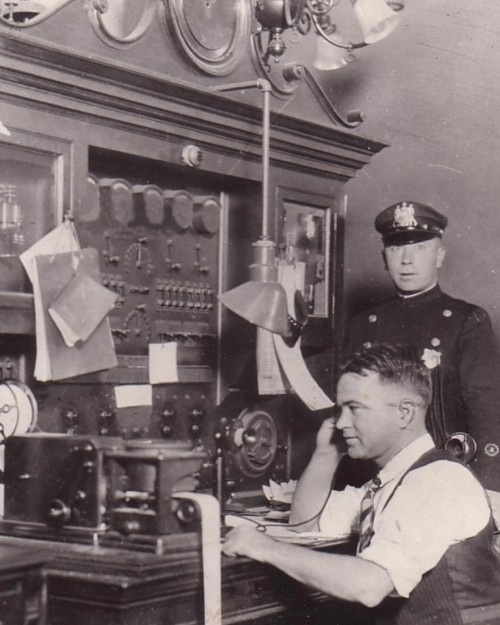
Police Lights Nemesis of Evildoers
![]()
8 November 1925
Like Scientist, Their Winking Rays Stand Ready to Issue Call to Urgent Duty or to Foretell Tragedy
Like a mischievous eye, a blue light was winking slightly at the edge of the sidewalk. Winking consistently and anyone who would look at it. At the same time, all over Baltimore hundreds of similar lights were also winking. The average pedestrian paid no more attention to the flashing light then to the ogles of an unattractive girl. Accustomed as he was to traffic signals, electric signs, streetlamps and the hundred and one other lighting devices which modern city life has evolved, he didn’t even notice this one. But scattered here and there over the city were some thousand men who leaped to respond at the first wink they saw with the alacrity of a lover at the call of his most cherished to sweetheart. They were members of Baltimore’s police force, and they knew these lights might have important things to tell them.
To safeguard the citizens of Baltimore from its members who have wandered off or slipped from the lawful course of life, the city has been divided into eight districts, when something goes amiss in any section it is possible to inform practically every Guardian of the Peace of that fact within a few minutes. Here is how it works: A store is robbed, perhaps in the Northwest section of the city. The thieves escape in an automobile. The owner of the store telephones police headquarters. There he is switched to the chief inspector’s office, where he excitedly gives such description of the men who robbed him and their car as he can recall. The Sgt. on duty helps the caller out by asking pertinent questions. Sometimes the person reporting is too upset to talk coherently.
Having obtained what information he can the Sergeant, almost before the man has finished talking, is giving the signal on a private wire which puts to eight police districts on the telephone at once. He gives the facts of the robbery just once, and all eight districts throughout the city have this theft on record. The man on the phone at each station house presses the button immediately. Blue lights begin winking all over the city, informing patrolman, motorcycle police and detectives working in all eight districts of the city, to call their district’s headquarters. As soon as each man on duty sees a flashing light, he calls the station house in his district and is given an account of the robbery.
Within a few minutes, ordinarily, the news has been flashed over the entire city by means of these blue lights winking from the top of police call boxes and from the roofs of station houses strategically placed throughout the city. There are in the city of Baltimore, 1350 patrolman, 170 sergeants, 25 detective sergeants, 25 detective patrolmen, and 25 lieutenant detectives, more than 1500 law enforcement officers in total. By the simple device of pushing a button, or flashing on a light by lifting a lever, it is possible to get in touch with most of this force scattered over the city in an incredibly abbreviated time. It has been quite a step from the days when the police used to communicate with one another by striking the sidewalk with their espantoons.
It is such an easy thing to push a bell or release a hook and flash on a light at the telephone exchange. Yet it strains the imagination to reflect upon what far-reaching and complicated processes such a simple little action can start. The chief inspector’s office is a fascinating place. There can be observed the mysteriously complex workings of the network of wires which are like the nerves of a modern city. In one corner is a little brass instrument connected indirectly with the main telephone's nervous system. It is used to convey information of a specialized kind, for an attempt to gain unlawful possession of private property.
This machine is connected with all of the approximate 100 banks in this city. When someone holds up one of these institutions an alarm can be sent to police headquarters by anyone at the bank who is lucky, or sometimes unlucky enough to be on hand to push a button placed in a convenient and concealed place for just such an emergency. Automobiles stand outside the courthouse waiting for such calls. The bell has hardly finished ringing off the signal which tells what bank is calling before detectives are speeding to that location. But much of the net used to trip up the criminally inclined before they have hardly started the telephone helps weave.
The telephone wire in the chief inspector’s office is kept hot all day, according to the Sergeant there, with signals of distress coming in from all over the city. Some strains, a few tragic, and many inconsequential things appear on the daily record sheet, where the requests for patrolmen are recorded. A woman reports a man looking in at her window. A dice game is seen, and police assistance is demanded to break it up. A fight is going on in a saloon on such and such or so and so Street. Two children were heard to cry out. But when the person telephoning got there, they were not to be found. A noisy party is extended its revelries too far into the night.
An automobile has been parked on the wrong side of the street for more than an hour, according to a woman who has been watching it from her front window. Some schoolboys playing ball on a nearby lot are too boisterous about it. Cries were heard coming from a neighboring house. A light is seen burning in an unoccupied building. Smoke is smelled at a certain street intersection. A woman is lying under a streetcar. A man dropped dead on the corner. A couple has been asphyxiated at a house on Fayette Street. A drunken man is lying in the gutter near a certain corner. Among all these, there will appear occasionally some strange bit like this; Mrs. C. reports that the new fence post around her yard was removed and warm eaten posts were substituted for them. Or Mr. B. says he is being followed continually, and that a Dictaphone has been installed in his room to listen to what goes on there.
“But we always treat all requests for service of one of our patrolman seriously, no matter what the nature of the request,” says the Sergeant. “We send a man up who looks at the fence post quite gravely, suits the fears of the woman and returns to the office to report that she “is or isn’t quite right.” “Yes, we have quite a few of these curious calls. Some of them coming regularly from certain sources which we have learned about from previous experience. We have a list of these regular customers of ours, so we know how to take them. Most of the complaints come by telephone, but there was one call recently which was too indignant to be trusted over the wire. Therefore, the woman came in, in person to deliver her complaint or investigation. “I want to report a traffic officer,” she said. “He just called me a Jaywalker. I don’t know what he meant, and I don’t know what a jaywalker is, but I will have you know, that I will not be called such a name by your officers or anyone!” But the face to face complaint or request for a patrolman are rare; probably it is well for the chief inspector’s office that it is.
The telephone has many advantages other than that of a time saver. Police departments all over the United States can get or give information more quickly this way and cooperate in catching criminals who have fled from one city or jurisdiction to another. There is the cable for still further distances. A button may be pushed in Baltimore or a lever released to flash a light and vibrations from that simple little act may cover a good portion of the city or the entire Western Hemisphere, going for months, or even years at a time. Man is a thinking animal, a clothes-wearing animal, a tool-using animal, men of letters have said at various times, all vying with one another in defining a human being in the shortest terms. The last of these, a tool-using animal, perhaps, is best for modern uses. Man is a tool-using animal, but in recent years he has learned to work many of his tools by merely pushing a button.
![]()
Bank Hold-up Foiled by Blinking Lamps of the Recall Lights
8 September 1929
To whistle screamed, the brakes on an exceedingly long an exceedingly yellow roadster screeched. The traffic policeman strolled to the side of the car being driven by Robert Calkman, of the deal, and son of a prominent family.
The little green light at the tops of police boxes and flashed over the city and policemen had been instructed to keep on the lookout for just such a roadster.
An anonymous letter to the police had intimidated that murder had been done on the old Cheshire road. And a yellow roadster had been seen to these the road late at night.
He looked as if the jig were up. What would happen to little Mary dell it’s up now? What of his engagement to Marjorie Marabe? What further complications would crowd themselves into an already the warring situation? Dashed such were the thoughts of Robert Calkman as he looked into the face of that traffic policeman…..
“Married Ella,” by Julianne Moore, is the story of modern love and the center. Don’t miss the first chapter
![]()
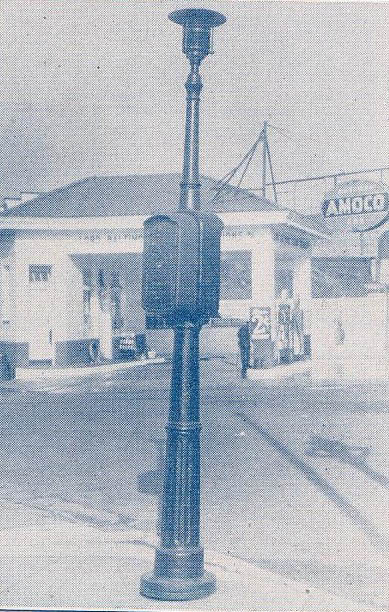
Call Box with Recall light on top
This is the First Model/Issue Baltimore Recall Light
Notice the Top is More of a Flat Pan than a Raised Top
Recall light hit the streets and our Officers came up with a way to have the kids in the neighborhood get involved. The first kid to let the officer know the light was on would get a penny. Officers rarely missed calls, and build a rapport with the kids, which later grew into receiving tips on other wrongdoers in the area. If we look at the Recall light on top this call box pole, we'll notice it is the old style, 1921 cast arm bowl homemade lamp
![]()
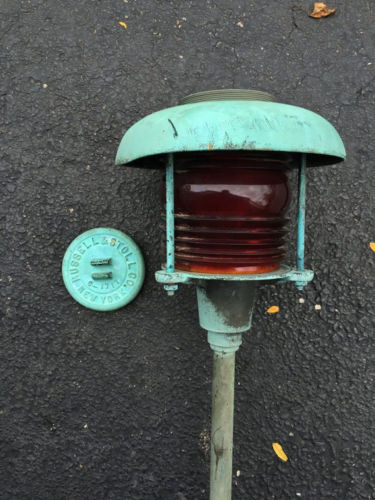
We can see from the Green Patina that this is an Old Tarnished Brass
This is the Fourth Model/Issue Baltimore Recall Light
Notice the Patina showing this is Brass and Tarnished
This date back to the 1920's, initially they were homemade in-house right here in Baltimore by our construction and repair machine shop. Using scraps, from around the shop and marine unit, they came up with a system that utilized a nautical lamp and globe, along with clock parts, once the system was proven, they contacted the company best known for nautical outdoor lighting. That company is the Russell & Stoll Company out of New York. Looking at this lamp some might think it is time to break out the Brasso © but I tend to like this coloring, known a "Patina" or "Verdigris" it is carbonate or oxidation and comes out most often from copper, bronze or brass. (It reminds me of the Statue of Liberty and I don't know about you, but, I wouldn't want t see Lady Liberty in any color but that beautiful green patina/verdigris).

In this set up I like the extra long pole raising the lamp high enough for officers to see from the edges of their post, still officers would pay the neighborhood kids to keep an eye on it, and like a game the first kid to alert the officer that the lamp was going off, would get a nickel, a quarter, or a fifty cent piece depending on the era, the 20's 40's or 60s. Eventually, when the radio car first started, they had a kind of Recall light for the radio car called a C-Code light, it sat on the roof of a Radio Car and when the officer was out on foot and dispatch wanted him or her they would activate the C-code lamp, the officer could see this small light from a distance and make his way back to his car to answer the radio. BTW, not all patrol cars were radio cars

This small-cap came off the top of the lamp to let the maintenance crew change the bulb out. The globe initially used was amber, though, over time when a globe was broken and the department needed to use whatever they had on hand until a new globe came in, they would use while Amber was the preferred color, we had several red, and even one blue globe.
![]()
A MYSTERY POLE LOSES STANDING
25 July 1955
After Catching Public Eye, it Finds an Unblinking End
Inspector William E. Taylor director of communications for the police department and local highway engineers have written "finis" to the story of Baltimore's mystery pole. The simple green pole, in mid-sidewalk at the northwest corner of the Broadway and Monument street intersection, was taken down at the end of last week. Highway engineers wrote the police several days ago to suggest that it be removed, calling it an "obstruction."
Creates Mild Furor
The pole, which at one time served as a recall light with a flashing signal to attract policemen to a nearby call box, had become a mystery recently when neither the police nor several city departments would admit having put it there. It created a mild furor among curious persons who asked about its function and labeled it variously a "hazard" and a possible "bumping post for the blind.” Inspector Taylor said that a pole had stood on that site for some seventeen years. The original pole was hit by a truck early in July, breaking the light bracket at the top and damaging the pole.
![]()
Research over Lens Colors
Over the course of our research we have read these Recall Lights described as having been distributed first in the 1922 article as having been RED in color, then in the 1925 article, the author described the lights as having been BLUE. The bulk of the recall lights we have recovered over the years; and those we have been told of by the men who were alive and working the streets when Recall Lights were still in use, describe them as having been a brown or amber color. In our best effort to set the record straight, we have officers that recall having seen one blue light that was still in use in the 1980's and a couple red globes scattered throughout the districts around the time these lights were being taken down. Most of these Red and Blue lamps were on the west side of Baltimore. In an effort to preserve our history we have purchased or were given several recall lights, three amber/brown and one red. We also purchased a globe for the museum downtown and it was red. which will be nice as it will help convey the original design which was built right here in Baltimore as described above; that lamp was built using an electric light bulb, a washbasin to shade the bulb and a Marine lens. The first three lamps we obtained are all different, and appear to be one from each stage of these lamps progress in manufacturing, the oldest has a washbasin, the second is commercially manufactured, but made of a cast iron, and the latest is identical to the second but made of a brass material to avoid rust. The mechanism for the flashing apparatus was said to have consisted of an alarm clock. We have many of these raw handmade parts here in our collection.
![]()
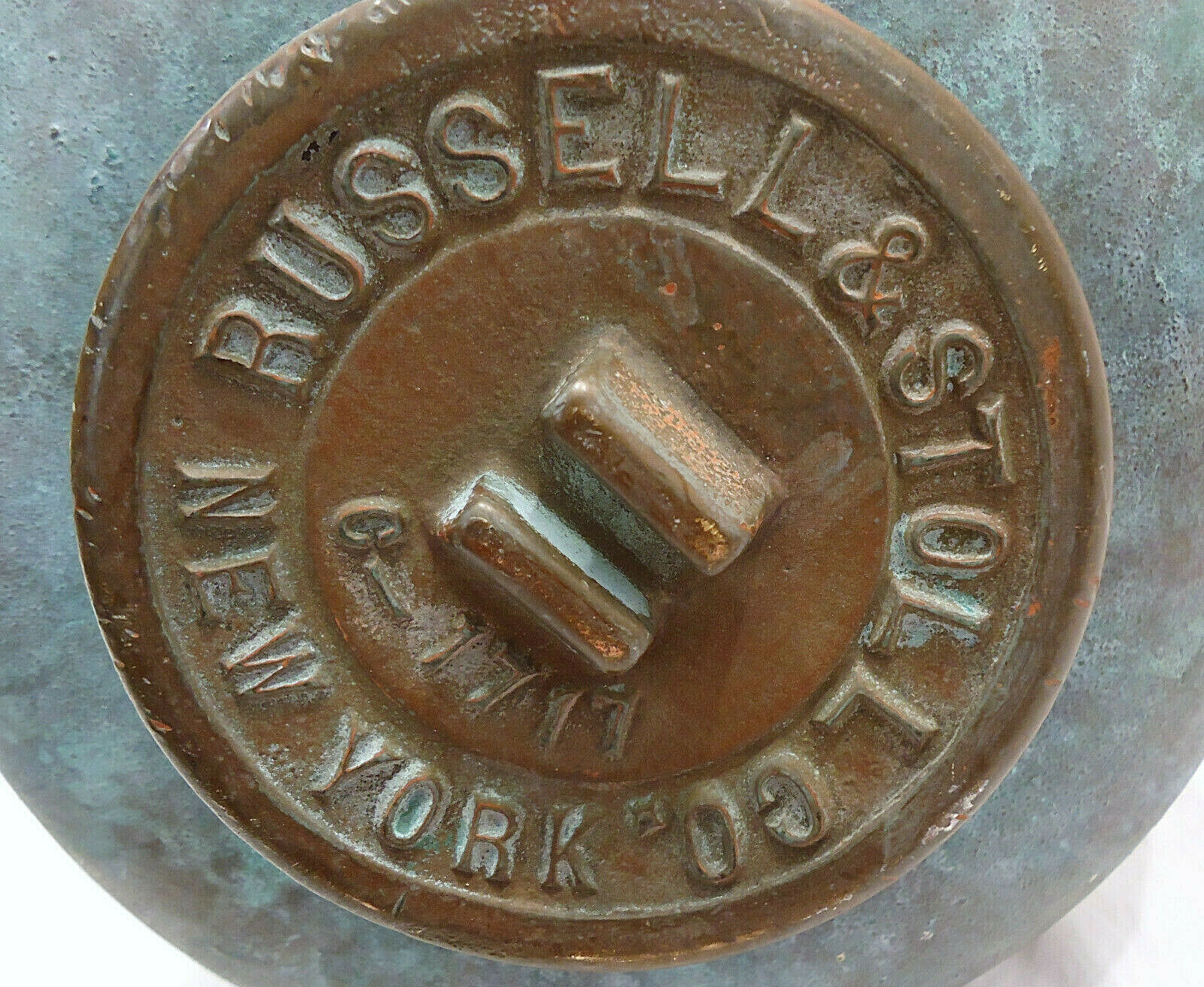
On 17 Sept 1922, the program that started in 1921 gets off the ground, going from a trial system to a full-fledged operational program. - A signal light on top of or nearby call boxes were installed, the location was on the southeast corner of Baltimore and Charles Streets. The signal was made up of an electric light bulb, with a washbasin added to shade the lamp and a marine lens to protect it from the weather. The mechanism to operate the light was located in the old Central District Station House (at the time located on Saratoga near Charles Street). The device consisted of an alarm clock to make the lamp flash. This method of notifying an officer that he was wanted, proved to be very successful. By 1945 there were 269 recall lights in operation throughout the city, of course, they were much more refined by that time compared to the more primitive design of the makeshift lamps used in 1921. By 1945 they had gone to a full-fledged market lamp made by the Russell and Stoll Co. New York. The 1945 recall system consisted of one commercial sign flasher in each of the then 8 district station houses, which carried 110V to each of the recall light locations on or near the area Call Boxes, and were operated with a steady, or flashing light by the telephone operator in each district.
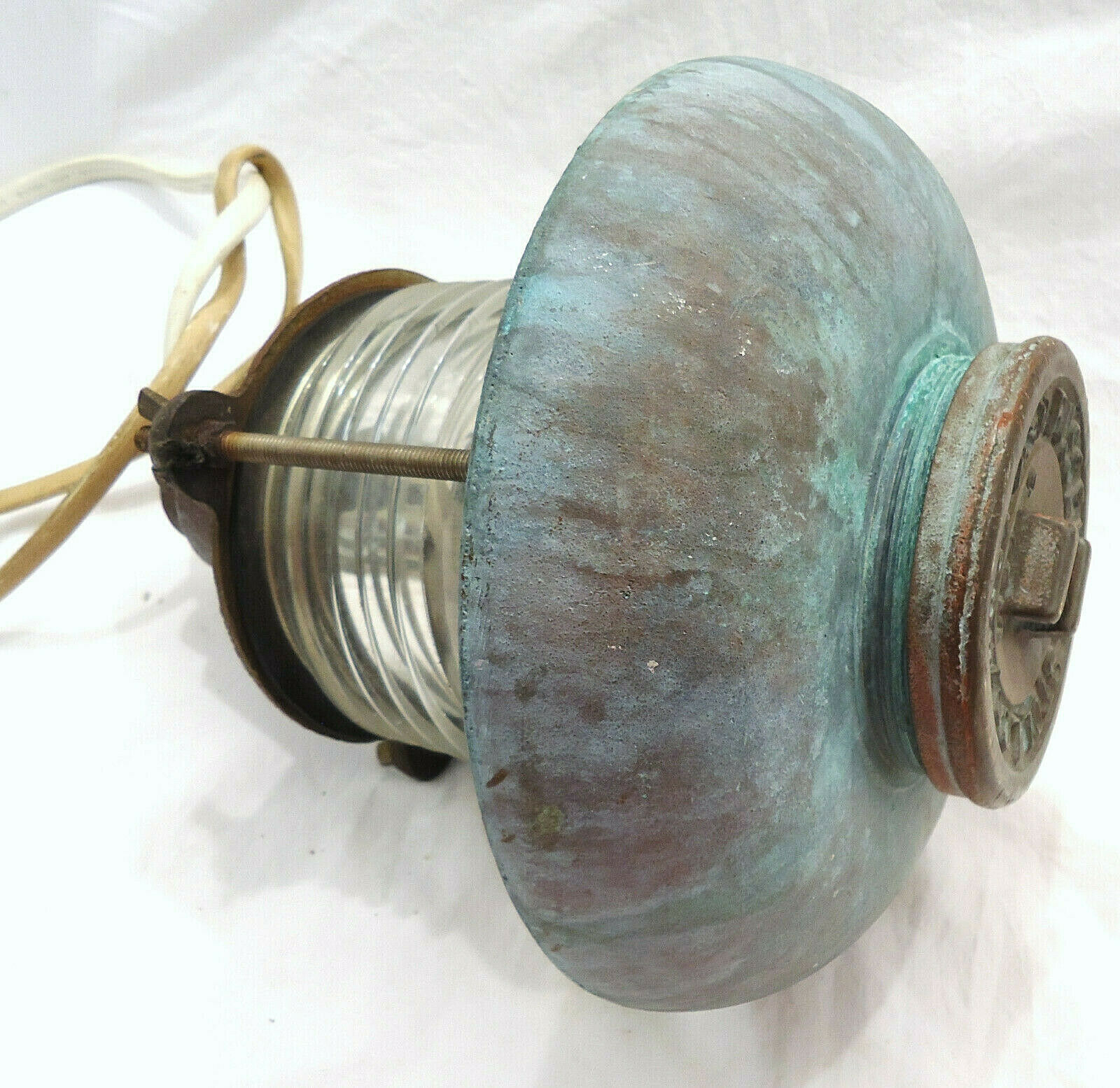
Note: These "Recall Lights" were initially handmade by our maintenance crew. Police of the Central District began operating the new police Recall System. At the time, every uniformed man from the inspector to the patrolman was enthusiastic over the results. The first week of the "Magic Blinkers" had created a demand from other districts, to other jurisdictions and then around the country to other departments... the system would eventually be installed in nearly all police department in the United States at a reasonably fast rate. Also regarding the Russell and Stoll Co. Recall lights, Baltimore initially purchased a cast iron/steel lamp, but maintenance issues caused by weather made them more work than they worth so the later lamps were made of brass. In our collection we have 4 recall lamps, one of the first home made lamps, and 3 Russell and Stoll Co. lamps two made of the Brass (one in untouched tarnished condition, and one that has been polished.) We also have one of the older Steel Russell and Stoll Co. lamps. We have been told there was fourth style lamp made of the thinner materiel that so far we have not seen, but will keep an eye out and update this page as that information becomes available.
![]()
Street Lights
Note - This information on Recall Lights shouldn't be confused with information on Street Lights Click HERE
Further - If you somehow found this page without having seen the Call Box page Click HERE
NOTES
Over the course of our research, we have learned that the lenses also known as globes on our Recall Lights have been described as having been a RED color, a BLUE color, or a BROWN / AMBER color. The bulk of the recall lights we have recovered over the years; and those we have been told of by the men who were working the streets when the Recall system was in use, describe the lenses/globes as having been a BROWN / AMBER color. I should point out that much of the reason we used the colors we used had to do with traffic lights, so it is interesting that two of the colors used were also used in traffic lights. In our best effort to set the record straight, we have spoken with many of the officers mentioned above, and the bulk of them remember having seen a BLUE light that was still in use in the 1980's on a box near the Pine Street Station. As well they spoke of a couple of RED globes scattered throughout the districts on the west side of Baltimore during the mid to late 1980's around the time these devices were being removed.
As previously mentioned most of the RED and BLUE lamps were seen on the west side of Baltimore. In an effort to preserve our police history we have purchased and or were given several of these old Baltimore Recall Lights, and are always looking for more. Three of those we have are AMBER / BROWN, and one has a RED lens. We also purchased a globe for the Recall Light in the museum downtown. We felt the absence of a lens in the museum was sending the wrong information at what could be a crucial teachable moment.
Interestingly enough the lens on the museum's recall light was missing or broken prior to the museums having been opened in the 1980's so the people that put everything together back then fashioned a lens from an old Gatorade bottle, and to be honest for those that didn't know, or bother to look close, it worked quite well. In fact, I think the Gatorade lens, was a better option than leaving it without a lens at all. The others that worked on the museum did a great job, but without a lens were forced to go without anything, and in an effort to tell the story painted the top of a light bulb blue. It looked nice, but in my eyes we were potentially spreading misinformation, possibly leading people to think the Recall Light had no lens and a blue bulb inside.
The short version as to why I was against not having the proper type lens (or a reasonable substitute) in the museum's Recall Light oddly enough comes from another product of the 1920’s and even more peculiar is that the other 1920’s historical event involved Harry Houdini. To be more accurate while the event concerned Harry Houdini and his 1926 death, it actually occurred in 1953. I will attempt to put the full story on our website under a Harry Houdini page, but for now lets just focus on the discrepancy in Houdini’s death and how a 1953 film starring Tony Curtis and Janet Leigh, began a common myth often heard concerning Houdini’s death, and how it was believed by so many that he died on stage during a performance by drowning in a failed upside-down Chinese Water Torture Escape. For years, even some of the most well-versed magicians that have studied various forms of magic, and magic performances thought Houdini died on stage doing that trick. The truth be told Houdini died in a hospital on 31 Oct 1926 from a ruptured appendix that most likely resulted from a punch to the stomach by a college student named J. Gordon Whitehead. Harry used to do a stunt in which he could take a sharp punch to the abdomen, and on the 22nd of Oct 1926, Whitehead punched Houdini in the stomach before he was prepared to take the blow.
The point is, whether it be Harry Houdini or the color and type of lens on a Baltimore Recall Light, correct information where it is known, and possible should always be represented. Especially in a museum setting where people come to learn the truth and rely on us to do the research and show our visitors what we have found. As misinformation can cause others to be incorrectly educated, and from there spread this misinformation to others, we should always do our best to convey an accurate historical picture the first time we show/teach it. Something I have always enjoyed about having something that is not 100% accurate, we need to speak up and use that incorrect information as an icebreaker to talk about the error and what it would take to make it right. At the museum, we have a motors Radio/PA system, and it initially had a grey handheld mic. Anyone that worked motors would know the all-weather outdoor mic that goes with the motors radio PA is black, not grey. So we went a looking, and I'll be honest, I could have taken a grey mic, disassembled it, painted parts of it black, and a sort of dark grey then put it all back together, and it might have cost us $50 or $60, it would have also opened the door during a visit to show the work we did to a motor's man, we would have gotten a good laugh and moved on. For the non-motor's man, it would have been educational and opened the door to something they knew nothing at all about. However, in the end, we found an outdoor mic that was NOS the seller wanted $$80 before shipping. So for less than half of what we would have had to pay for the faked version but half the original value, I picked it up. As often as possible we should gather and present authentic Baltimore Police equipment actually, when that becomes impossible or unlikely we should attempt to pick up equipment from that period, be it one of the neighboring departments, or an agency clear across country, as long as it is the same make, model, etc. it will suffice, and as a last resort, when all others have failed, we can resort to having a reproduction piece of equipment made. I am not against using photographs, mixed in with parts of actual equipment, I fact I think even with actual equipment of our past, we should have photographs of it in use. Sorry, I have gotten a little off track, All I wanted to say was based on the obvious problems of not doing all we can to portray a display as close to accurate as possible we run the risk of providing the wrong information thereby educating people with incorrect information. In the case of the lens/globe, it would have been ideal to have an AMBER / BROWN lens, but until that day comes a RED globe is better than no lens, and opens the door to tell the story of how the Recall Light came about, and how we initially started with a RED lens, and then due to the commissioner at the time also working on the traffic light system and his wanting a three light system, RED, GREEN, or AMBER he couldn’t have a RED globe. This is also why we didn't use a GREEN lens.
While it was not the preferred AMBER / BROWN color, it was RED. As suggested AMBER / BROWN would have been more accurate we understand the difficulty and expense of finding these lenses in the right size and color using a RED lens was understood. So we look at this and any issues with finding actual Baltimore Police items as a silver lining of in this case.
Now might be a good time to tell the story, when Commissioner Gaither was in office, he started to research the Semaphore traffic control system. The Semaphore was a system in which traffic officers would stand in the middle of an intersection with what was often referred to as a "STOP-STOP / GO-GO" signpost in which a signpost with an intersecting signs affixed to the top of the post had the words STOP-STOP on one section interlaced with two more signs that read GO-GO. With this, while the officer had STOP-STOP pointing at say, Eastbound, and Westbound traffic Northbound, and Southbound was reading GO-GO. Turning the sign 90 degrees would now have Westbound and eastbound traffic seeing STOP-STOP, and Southbound, and Northbound traffic was seeing GO-GO. It was that simple, like a flagman by turning the signpost 90 degrees back and forth oncoming traffic from all four directions would either see, STOP-STOP or GO-GO. From this, other cities across the country were all working to come up with a traffic light system more like that which we have today, most of the people involved wanted two lights, RED and GREEN. For a little while the Semaphore had a light affixed to the top, this light came from the railroad system, Gaither sat out and watched his intersections and realized we need more than two lights, he saw pedestrians and left turning vehicles stranded in a two-light system. So he introduced the third light, AMBER this Amber light gave pedestrians and left turning vehicles time to clear the intersection. So why would he not allow RED or GREEN lights in his Recall System, but had no problem with AMBER? The answer is simple, but first, let's talk about why RED and GREEN were not wanted on the system. He felt from a distance, day or night, an officer could mistake a Recall light for a Traffic light and not answer when needed, He further thought that at first officers may respond to the light, but as he got closer he would realize it was not the Recall light, eventually officers would stop responding thinking it was a traffic light in the same line of view. They went to the BLUE lens but quickly found the cobalt BLUE glass to be expensive and with vandalism. Now if Gaither feared RED and GREEN would great a boy who cried Wolf effect, why did he not have the same fear of the AMBER light, a light he was working so hard to push for the new Traffic light system. Well if we think back to when we were kids, and since while dealing with my kids and my grand-kids; what did, or do most of them respond when asked to name the colors of a traffic light? Every kid I ever heard answers, "RED, GREEN, and YELLOW." However, when asked about the AMBER light of a Recall light most people describe it as brown, while the AMBER of a traffic light is deemed by most to be YELLOW. With that, there was no fear of officers mistaking a traffic light several blocks down with a recall light, and eventually ignoring the light with an excuse of mixing lights up. I should point out, that this may have been as much a real fear as trying to avoid a situation where an officer could say he thought it was traffic light as an excuse for avoiding answering a call box, or maybe to avoid having the public say they thought the light was a traffic light, so they entered the intersection.
At least having the right size lens, from the right period in history; a RED lens can still be a nice way of helping us to convey the original design which was built right here in Baltimore as described above. The lamp was built using an electric light bulb, a simple metal washbasin to shade and protect the bulb from above and a Marine lens/globe to protect the lamp from weather-related damage or vandalism. The four lamps we have obtained for our private collection are all different (to a degree), Appearing to be at least one from each of the three stages of these lamps progression in history and manufacturing, the oldest having a primitive washbasin shaped metal bowl, the second is commercially manufactured, but made of a cast iron, and the latest is identical to the second but made of a brass material to avoid rust. The mechanism for the flashing apparatus was said to have consisted of an alarm clock. We have many of these raw handmade parts here in our collection. Unlike today the entire system was new and who knew what anyone would think. The webpage on Recall lights will explain the lens colors; also, some reporters at the time referred to GREEN lights, while others referred to RED lights while talking about Recall lights. We never used a GREEN lens on the Recall light system, so while trying to figure out what they were talking about
On 17 Sept 1922, the program that started in 1921 gets off the ground, going from a trial system to a full-fledged operational program. - A signal light on top of or nearby call boxes were installed, the location was on the southeast corner of Baltimore and Charles Streets. The signal was made up of an electric light bulb, with a washbasin added to shade the lamp and a marine lens to protect it from the weather. The mechanism to operate the light was located in the old Central District Station House (at the time located on Saratoga near Charles Street). The device consisted of an alarm clock to make the lamp flash. This method of notifying an officer that he was wanted, proved to be very successful. By 1945 there were 269 recall lights in operation throughout the city, of course, they were much more refined by that time compared to the more primitive design of the makeshift lamps used in 1921. By 1945 they had gone to a full-fledged market lamp made by the Russell and Stoll Co. New York. The 1945 recall system consisted of one commercial sign flasher in each of the then 8 district station houses, which carried 110V to each of the recall light locations on or near the area Call Boxes, and were operated with a steady, or flashing light by the telephone operator in each district.
Note: These "Recall Lights" were initially handmade by our maintenance crew. Police of the Central District began operating the new police Recall System. At the time, every uniformed man from the inspector to the patrolman was enthusiastic over the results. The first week of the "Magic Blinkers" had created a demand from other districts, to other jurisdictions and then around the country to other departments... the system would eventually be installed in nearly all police department in the United States at a reasonably fast rate. Also regarding the Russell and Stoll Co. Recall lights, Baltimore initially purchased a cast iron/steel lamp, but maintenance issues caused by weather made them more work than they worth, so the later lamps were made of cast brass.
In our collection, we have 4 recall lamps, one of the first homemade lamps, and 3 Russell and Stoll Co. lamps two made of the Brass (one in untouched tarnished condition and one that has been polished.) We also have one of the older Steel Russell and Stoll Co. lamps. We have been told there was fourth style lamp made of the thinner material that so far we have not seen, but will keep an eye out and update this page as that information becomes available.
UPDATE
From everything we read and everything we had been told by those that were old enough to remember, we didn't have GREEN lenses, and every time a lamp was refereed to as GREEN they were referring to the frame/casing that held the lamp and not the lamp. Over this past week, Ken was feeling better and dug in deep to his research on the Recall lamps/lights as he wanted a firm answer, something in writing and not just word of mouth or memory. He eventually found that as is common with gathering information based on memory and hearsay. The folks that provided the information were off somewhat in their memory of the events but Ken is always thankful as he knows these errors were not malicious, Heck, ken often says, he was hit in the head once, and that could be in response to what he had fore breakfast, so trying to tell someone what color the lens was on a recall lamp when he was 5 might present a challenge. With that I want to be sure to thank anyone that has provided ken with information over the years, even if it was in error, we both know, you all could have ignored ken's requests for information, and I should say that even incorrect information, is a step further in the right direction. So we learned The First Recall Lights in Baltimore came about from an idea Commissioner Gaither had while seeing a similar warning system used by business in which a blinking light outside let people know they should contact police, and that there was an emergency taking place inside. (Today this system is still used with some downtown parking garages) So, Gaither contacted his Construction and Repair department and requested they make a similar system that could be built into the existing call boxes. A system in which any emergency calls coming into the police could be quickly relayed to the patrol,am on the street.
This is why Ken enjoys gathering historical information from old-timers that have both witnessed these things and heard of them from their family. It is part true and part failed memory, so where he was told the colors were affected by Traffic lights which were going p around the same time, which prevented the recall light lenses from being RED or GREEN, there were GREEN lenses
![]()
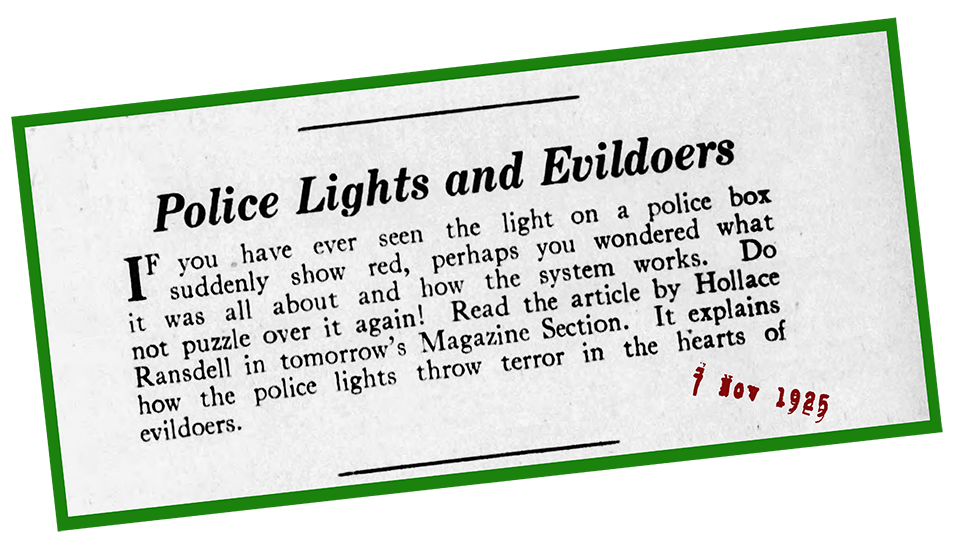
![]()
Keep checking back a great story will go here, we are waiting for the information and confirmation. Please contact Det. Ret. Kenny Driscoll if you have any pictures of you or your family members and wish them remembered here on this tribute site to honor the fine men and women who have served with honor and distinction at the Baltimore Police Department. Anyone with information, photographs, memorabilia, or other "Baltimore City Police" items can contact Ret. Det. Kenny Driscoll at
![]()
POLICE INFORMATION
Copies of: Your Baltimore Police Department Class Photo, Pictures of our Officers, Vehicles, Equipment, Newspaper Articles relating to our department and or officers, Old Departmental Newsletters, Lookouts, Wanted Posters, and or Brochures. Information on Deceased Officers and anything that may help Preserve the History and Proud Traditions of this agency. Please contact Retired Detective Kenny Driscoll.

NOTICE
How to Dispose of Old Police Items
Please contact Det. Ret. Kenny Driscoll if you have any pictures of you or your family members and wish them remembered here on this tribute site to Honor the fine men and women who have served with Honor and Distinction at the Baltimore Police Department.
Anyone with information, photographs, memorabilia, or other "Baltimore City Police" items can contact Ret. Det. Kenny Driscoll at
Copyright © 2002 Baltimore City Police History - Ret Det Kenny Driscoll
